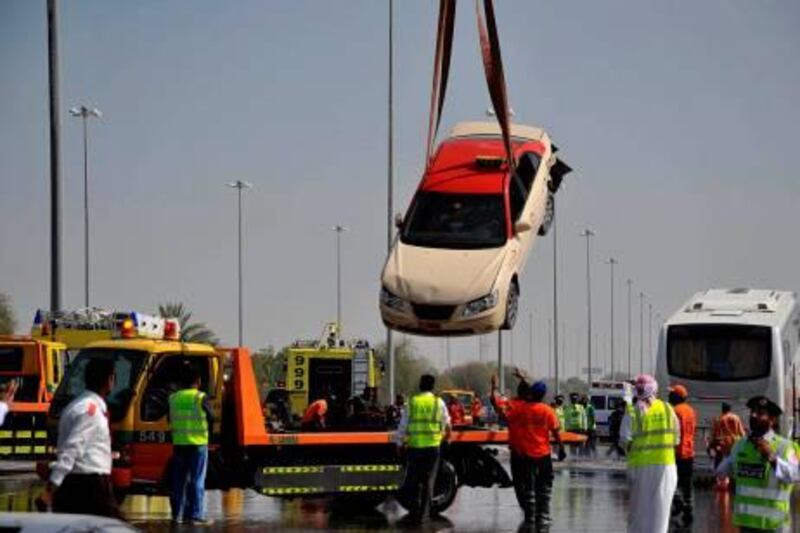ABU DHABI // Abu Dhabi Traffic Police are urging the Department of Transport (DoT) to install illuminated message boards to alert drivers about road and weather conditions as soon as possible, following the 127-car pile-up on Saturday.
Traffic officials said such signs could have prevented the chain of accidents that resulted in one death and at least 60 injuries near Al Samha on the Abu Dhabi-Dubai motorway.
"These signs could give advanced notice of weather conditions and advise motorists to slow down and drive at a certain speed," said Brig Gen Hussein al Harethi, head of the Abu Dhabi Traffic and Patrols Directorate. "They could also inform drivers of existing accidents before they approach them."
_________
More
• Pile-up victims under observation
• Dubai-Al Ain E-66 motorway to be improved
Also
• Hard lessons of Fog Tuesday
• Fatal accident echoes deadly fog pile-up
• Two dead, 15 hurt as fog causes six crashes
_________
Brig Gen al Harethi said the traffic police had requested the signs since "Fog Tuesday" in March 2008, when more than 200 cars crashed during morning rush-hour on the E-11 near Ghantoot, killing four and injuring 350. Traffic police have now asked the DoT to speed up the process.
In December, the DoT announced the implementation of an Integrated Transport System (ITS), a five-year project to provide an advanced network of communication and information technology to drivers.
This includes short-term projects that are scheduled for completion before the third quarter of this year, including variable message signs and incident detection stations.
However, traffic police officials said such accidents were not a result of road and weather conditions alone.
Driving behaviour was deemed the root of the problem on Saturday, after a driver failed to slow down in foggy conditions and rear-ended the vehicle in front of him, causing a domino effect on the vehicles behind them.
"We always tell drivers: if there is fog slow down, or park and wait on the side of the road, and use the hazard lights only when necessary," Bri Gen al Harethi said. "Leave enough space between you and the vehicle in front of you and abide by the speed limits. Speeding and tailgating are reckless behaviours, regardless of weather and road conditions."
Such behaviour would not be tolerated, he said. Patrols would be intensified to catch offenders.
A representative from the National Center of Meteorology and Seismology said visibility that morning was less than 50 metres. Taking precautionary measures in such conditions was "common sense", he said.
"We knew in advance that the fog was approaching, and we released a series of warnings and notifications the previous evening to the police and traffic authorities," he said.
"However such an incident is mostly the fault of the driver involved. Even if the driver does not receive the message, he should recognise the fact that since visibility is low he should slow down. It's these drivers' poor judgement that put others in danger."
The quick response by police and rescue teams helped save lives. Police arrived at the scene in five minutes and cleared the roads two hours after the incident.
Long-term plans by the DoT that form part of the ITS project include a motorway radio system that broadcasts messages to alert motorists of road conditions, and a navigation system that feeds new cars with weather warnings, displaying them on built-in navigation systems or overriding their stereo system to issue the alerts.






